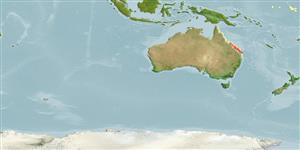>
Ophidiiformes (Cusk eels) >
Bythitidae (Livebearing brotulas)
Etymology: Microbrotula: Greek, mikros = small + Latin, brotula, -ae = little, bud, shoot (Ref. 45335); queenslandica: Named after the Australian state of Queensland where the types were collected (Great Barrier Reef) (Ref. 54832).
Environment: milieu / climate zone / depth range / distribution range
Ecologia
marino associati a barriera corallina; distribuzione batimetrica 22 - 30 m (Ref. 54832). Tropical
Southwestern Pacific: endemic to Australia.
Size / Peso / Age
Maturity: Lm ? range ? - ? cm
Max length : 3.1 cm SL maschio/sesso non determinato; (Ref. 54832); 3.0 cm SL (female)
Short description
Chiavi di identificazione | Morfologia | Morfometria
Raggi dorsali molli (totale) : 78 - 80; Raggi anali molli: 62 - 63; Vertebre: 48. A species of Microbrotula distinguished by the following set of characters: vertebrae 12 + 36 = 48; D 78-80, A 62-63, pectoral-fin rays 11, caudal fin rays 6; dorsal-fin origin above vertebra 7; anterior anal fin origin below dorsal fin ray 21; anal-fin origin below vertebrae 15–17; head with separated scale patches on cheek and occiput, absent on opercle; numerous papillae on entire head; no lateral-line papillae; forward-curved spine at lower angle of preopercle with two points, hidden by skin; 3 posterior mandibular pores, 1 lower preopercular pore; palatine with papillae-like teeth; elongated otolith, length to height, 2.3; otolith length to colliculum length, 2.3 (Ref. 88975).
Life cycle and mating behavior
Maturità | Riproduzione | Deposizione | Uova | Fecundity | Larve
Anderson, M.E., 2005. Three new species of Microbrotula (Teleostei: Ophidiiformes: Bythitidae) from the Indo-West Pacific. Zootaxa 1006:33-42. (Ref. 54832)
IUCN Red List Status (Ref. 130435: Version 2024-2)
Threat to humans
Harmless
Human uses
Strumenti
Special reports
Download XML
Fonti Internet
Estimates based on models
Preferred temperature (Ref.
123201): 26.1 - 26.4, mean 26.1 °C (based on 6 cells).
Phylogenetic diversity index (Ref.
82804): PD
50 = 0.5039 [Uniqueness, from 0.5 = low to 2.0 = high].
Bayesian length-weight: a=0.00447 (0.00172 - 0.01163), b=3.10 (2.87 - 3.33), in cm total length, based on LWR estimates for this (Sub)family-body shape (Ref.
93245).
Trophic level (Ref.
69278): 3.1 ±0.5 se; based on size and trophs of closest relatives
Resilienza (Ref.
120179): Alto, tempo minimo di raddoppiamento della popolazione meno di 15 mesi (Preliminary K or Fecundity.).
Fishing Vulnerability (Ref.
59153): Low vulnerability (10 of 100).
